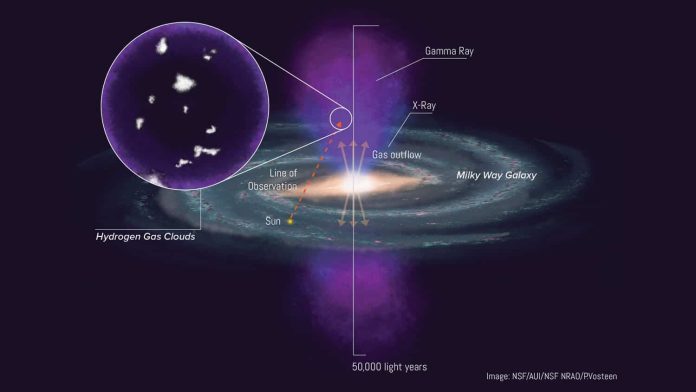
Astronomers have made a surprising discovery at the heart of our galaxy—the Milky Way.
They’ve found cold clouds of gas floating inside the blazing-hot Fermi bubbles, enormous structures of superheated gas that extend 25,000 light years above and below the center of the Milky Way.
The finding challenges what scientists thought they knew about how these bubbles formed and how old they are.
The Fermi bubbles were first discovered in 2010 by telescopes that detect gamma rays.
Scientists believe these bubbles were formed by a sudden, violent event near the center of the galaxy—something like a massive explosion or outflow of energy from the supermassive black hole.
Until now, most theories suggested that the bubbles were at least 10 million years old.
But new observations, led by Rongmon Bordoloi at North Carolina State University and published in The Astrophysical Journal Letters, suggest the bubbles are far younger.
Using the Green Bank Telescope in West Virginia, the team collected highly detailed radio data from inside the Fermi bubbles.
They discovered clouds of neutral hydrogen gas—much colder and denser than the surrounding environment—floating about 12,000 light years above the galactic center.
These clouds are massive, each containing thousands of times the mass of our Sun, but they’re also much cooler than expected—about 10,000 degrees Kelvin compared to the surrounding million-degree plasma.
Andrew Fox, a co-author of the study, compares the discovery to “finding ice cubes in a volcano.” That’s because in such an incredibly hot and turbulent environment, scientists believed cold gas couldn’t survive for long.
Computer models show that cool clouds should be destroyed in just a few million years. So if these cold clouds are still present, the Fermi bubbles must have formed more recently than previously thought—perhaps just a few million years ago.
The team also matched the location of the cold gas clouds with earlier ultraviolet observations from the Hubble Space Telescope. Those observations had already detected signs of gas in various temperature ranges, which now makes more sense in light of the new data.
They also measured the speed of the gas—about a million miles per hour—further confirming that the clouds were swept up by fast-moving winds from the galaxy’s center.
This discovery helps scientists better understand how energy and matter move through galaxies. It also offers new clues about how outflows from galactic centers affect their surroundings.
In cosmic terms, the Fermi bubbles may be brand new—and now, thanks to these cold clouds, we can finally trace their motion.
Source: North Carolina State University.



